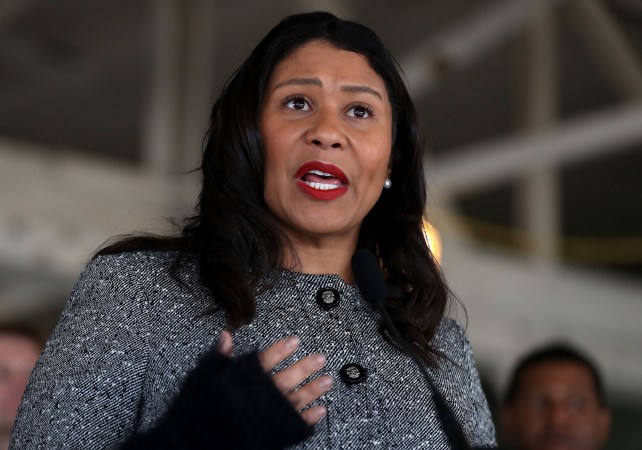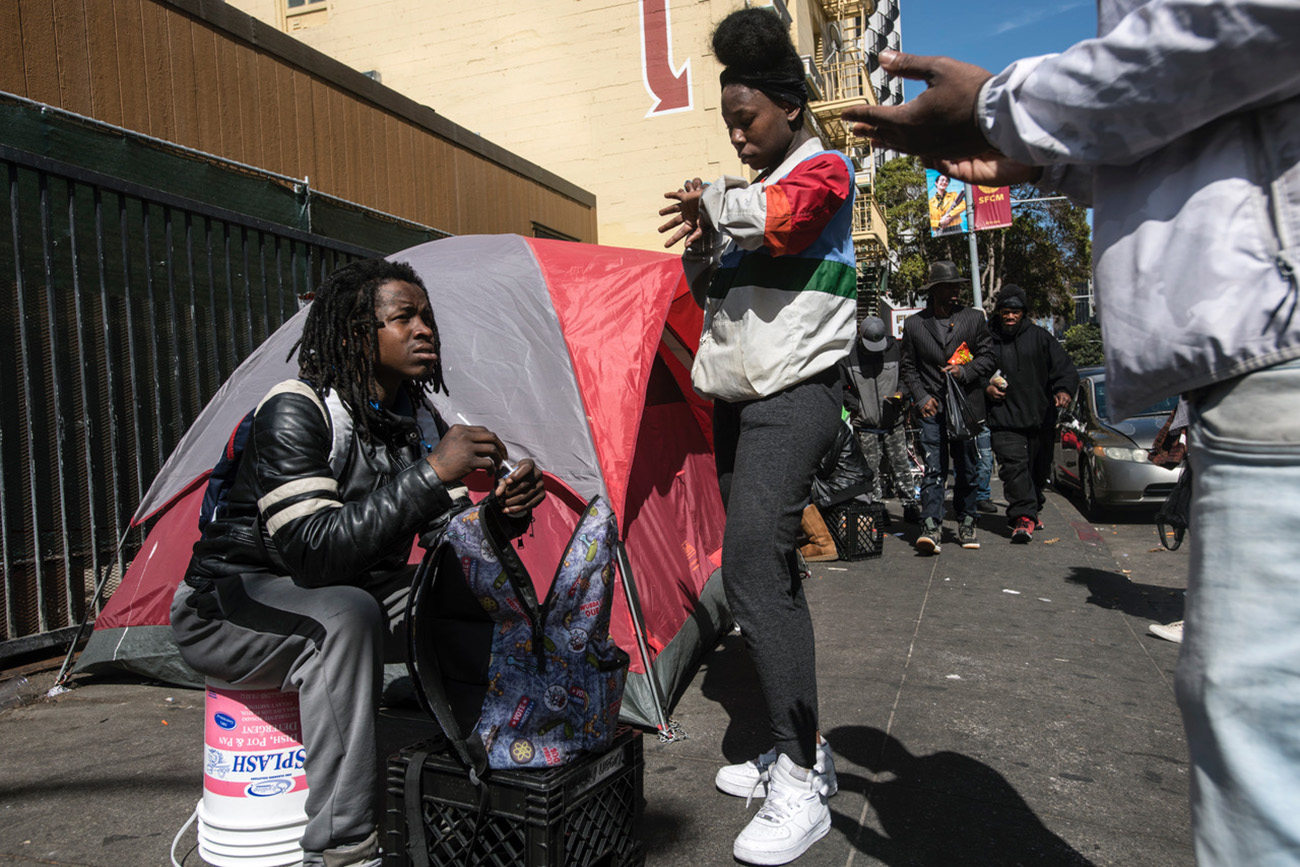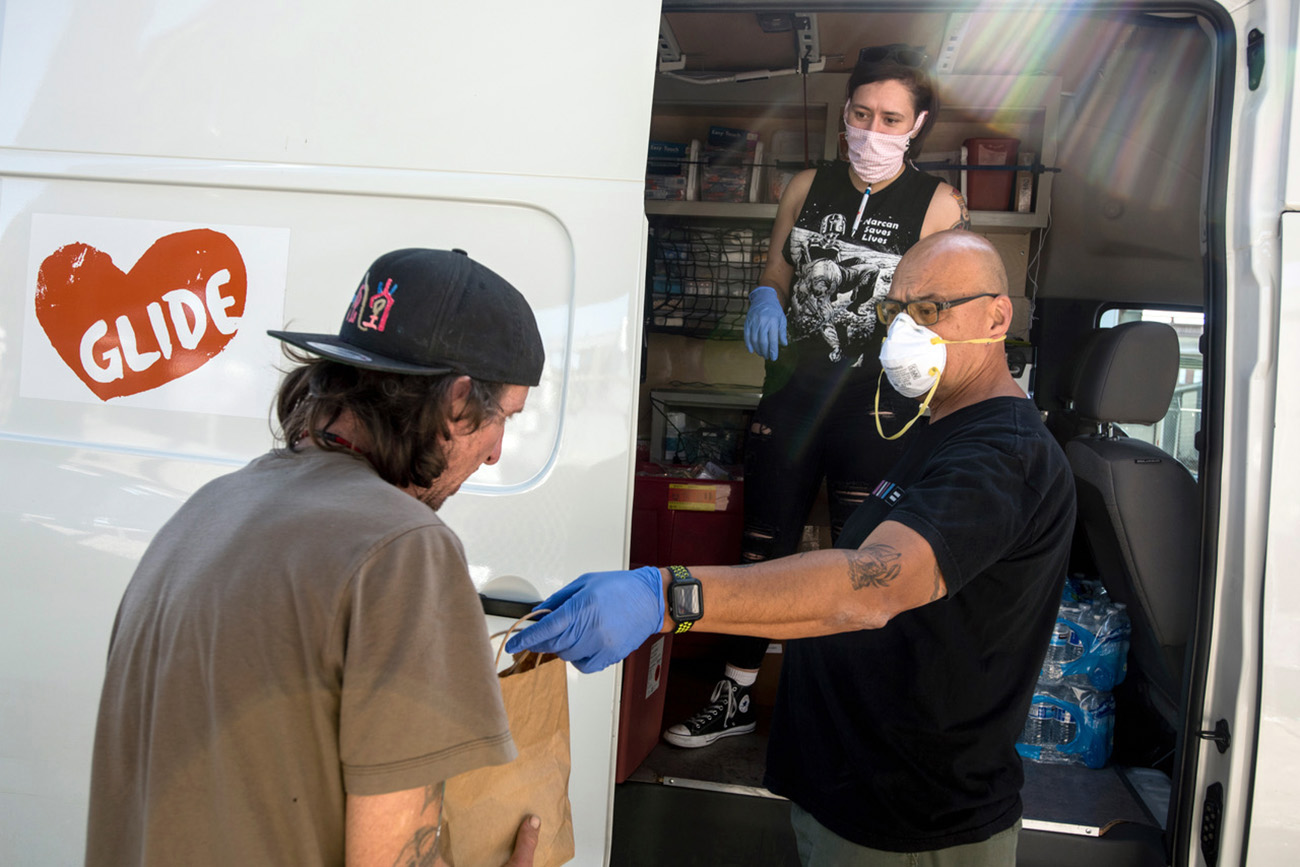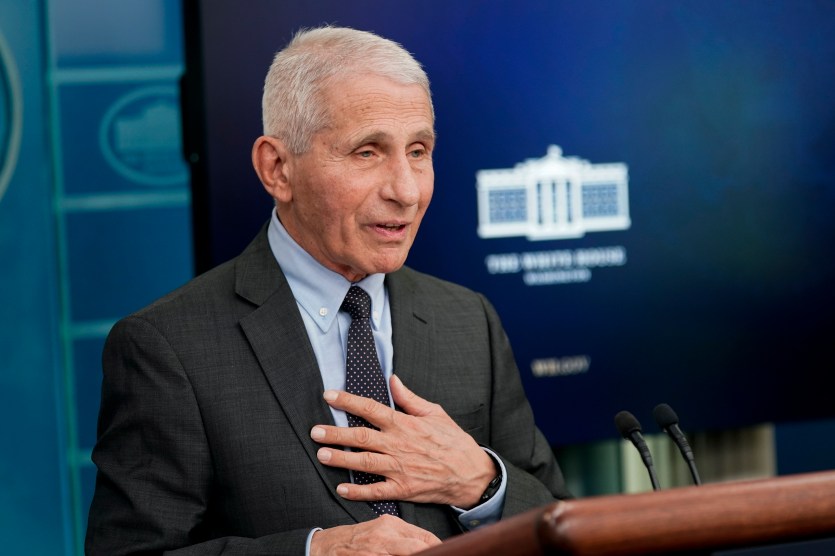The tents started popping up soon after the shelter-in-place order came down, in mid-March. By early May, some 90 of them were clustered in Civic Center Plaza, with more joining each day—a sprawling encampment of people without housing, little nylon domes dotting the square like a low satire of the ornate gold-leaf dome of San Francisco City Hall in the near distance.
In the tree-lined open space, things have settled into something of a routine over the past few weeks. Vans from various nonprofits roll up and dole out hand sanitizer, masks, bagged lunches, and bottled water. Cops attempt to enforce social distancing, on at least one occasion reportedly instructing people to stay in their tents after a 10 p.m. “curfew.” (There is no such city curfew; a spokesperson for the San Francisco Police Department said the cops were there to “reduce crime and remind the public about sheltering in place and social-distancing requirements.”)
Sarah Wasson, a 35-year-old who lives in a tent with her husband, noted that it’s hard not to spread germs when you don’t have access to bathrooms or showers. “They say we’re more at risk of spreading it to everybody else because we’re not clean like everybody else, but we can’t be,” she said when I visited the encampment at the end of April. “We don’t have a choice.”
Just this week, to help people like Wasson, the city unveiled a “safe sleeping village” in the plaza: Inside a fenced-off area, 50 tents sit in squares spray-painted on the ground like a checkerboard. Residents now have access to bathrooms, three meals a day, and 24/7 security. But there are far more people in the plaza than there are tent spots in the village. Asked what would happen to them, Department of Homelessness and Supportive Housing spokesperson Emily Cohen said, “We continue to seek more stable housing solutions and, when possible, to guide people experiencing homelessness to safer and less concentrated locations.”
In recent weeks, San Francisco has made national news as a glimmering case study in flattening the curve. Since Bay Area counties became the first in the nation to order residents to stay inside, the city has mercifully avoided the devastation that the coronavirus has wrought in other urban areas. The city’s ICUs have plenty of space. Of nearly 900,000 residents, just 2,000 have tested positive for the virus.
The glaring exception to all the good news is the homeless population, which has grown significantly over the course of the spring. The encampment in front of City Hall is one of several such sites that have sprung up across the city. As homeless shelters have emptied to comply with social-distancing measures, between 500 and 1,000 additional people have spilled into the streets, experts estimate, joining the roughly 5,000 who were already there. The number of tents in the Tenderloin, the 49 blocks that make up the city’s most impoverished neighborhood, has tripled since January. Last week, Tenderloin residents, including the Hastings College of the Law, sued the city for the neighborhood’s “deplorable” conditions: “What has long been suffered in the Tenderloin has become insufferable,” read the complaint.
There has not yet been widespread coronavirus testing of the homeless in San Francisco, but the data that does exist is eye-popping: A Centers for Disease Control and Prevention team responding to a coronavirus cluster at San Francisco’s largest shelter, MSC South, in April tested all 143 residents; 66 percent tested positive. The shelter promptly evacuated, with the residents moving into hotel rooms to self-isolate.

Julia Lurie
Homelessness has long been San Francisco’s glaring exception. As of 2015, the city had a higher rate of unsheltered residents than any other major city in the country. In the Civic Center Plaza today, there’s a sense of history repeating itself: In the late 1980s, Mayor Art Agnos could watch from his balcony at City Hall as a sort of makeshift city took shape in the same plaza. Then, as now, a natural disaster intensified a pre-existing crisis. The 1989 Loma Prieta earthquake forced people out of crumbling single-room occupancy hotels. They flocked to Camp Agnos, as it was known. The mayor refused to evict them until he had a place to send them, prompting the city to acquire its first two homeless shelters. As the fates would have it, one of those new shelters was MSC South.
With tents multiplying in the streets and the city government bitterly divided over what to do about it, San Francisco is facing the same old problems today, but dramatically heightened. “It’s what I went through, only multiplied by a thousand times,” Agnos told me. “Because, rather than just 3, 400 people, centralized, they’re all over the city. They’re all over the Bay Area.”
Dr. Margot Kushel, who heads the University of California, San Francisco’s Benioff Homelessness and Housing Initiative, described San Francisco’s pre-outbreak scenario as a “tinderbox.” Throw in a highly infectious disease, she said, “and you have the makings of a catastrophe.”
San Francisco’s successes thus far in combating the coronavirus look a lot more fragile from among the tents at Civic Center Plaza. An outbreak within the city’s substantial unhoused population could spread rapidly beyond it, to the people who in normal times are cosseted from the human consequences of the Bay Area’s housing squeeze.
“We are essentially fighting a plague while exempting tens of thousands of our residents from the protections that the rest of us have,” Supervisor Matt Haney, who oversees the Tenderloin, told me. “If you’re concerned about how long this is going to go, if you’re concerned about how much this is going to cost, if you’re concerned about whether or not the sacrifices that you are making and your family are making are going to be worth it, you should also be concerned about homeless people.”
Since Agnos’ tenure, the politics of housing in San Francisco have been characterized by a refusal to face homelessness head-on, as a matter of structural inequities with structural remedies. But in a pandemic, there is no denying that the well-being of those with shelter and the well-being of those without it are inextricably tied together.
When I spoke with Diane Yentel, the president of the National Low Income Housing Coalition, I asked if this coronavirus could, at last, force a reckoning with homelessness. “If this moment doesn’t,” she said, “I’m not sure what would.”
On March 17, the day that Bay Area counties ground to a halt, the San Francisco Board of Supervisors held an emergency meeting. Dr. Tomás Aragón, the city’s lead health officer, admitted that he was losing sleep over the possibility of a massive outbreak among the thousands of people living on the streets or in group housing, like shelters or SROs, where residents are lodged in close quarters. “Hours matter: This virus, the way that it moves, is explosive,” he said. “I think we can have an explosion just in those populations.”
Soon after, the city ordered shelters to stop taking new reservations. The decision was “one of the hardest things I’ve ever had to do,” said Abigail Stewart-Kahn, the interim director of the city’s Department of Homelessness and Supportive Housing. “That immediately spilled people out into the streets.” The shelters typically hold about 3,000 people, a large portion of whom are same-day walk-ins. Today, the city’s shelters are between 5 and 40 percent full.
While virtually everyone agreed that shelters weren’t safe, city leaders were—and continue to be—deeply divided about what to do next.
On one side are the city’s left-wing supervisors, who insist on placing people without housing into San Francisco’s thousands of empty hotel rooms. As the supervisors explain it, this is a no-brainer: Hotels are desperate for business. Unhoused people are desperate for shelter. The city could get a large portion of the costs covered by Project Roomkey, a statewide initiative using FEMA and state funding to secure “isolation rooms” in hotels and motels for vulnerable populations. “We have the hotel rooms, we have the money, and we have the staffing,” said one supervisor, Hillary Ronen, at a press conference in early April, just after the first resident of a homeless shelter had tested positive for the coronavirus. “Why aren’t we doing this?”

Justin Sullivan/Getty
On the other side is the city’s executive branch, led by Mayor London Breed, the hero in the national narrative of San Francisco’s pandemic response. Breed maintains that it is not realistic to expect to solve in a matter of weeks a homelessness crisis that has been decades in the making: “I know that people are asking, ‘Well, why don’t we just open the doors and let everyone who is homeless get access to a hotel room?’” Breed said in early April. “I wish it were that easy to help people.”
Breed’s team agreed to acquire some hotel rooms but for a limited population—namely, homeless people who had tested positive, and people in homeless shelters or on the streets who are elderly or sick. But a number of obstacles prevent them from housing all the city’s 8,000 homeless people, they say. First, there’s the matter of the budget: Trent Rhorer, the executive director of the San Francisco Human Services Agency, said last month that “it would not be fiscally prudent” for the city to rent thousands of hotel rooms for “a population that does not require an urgent COVID health quarantine or isolation intervention.” Then there was the concern that isolating people with severe mental illness and addiction problems into hotels would be dangerous—particularly since people are far more likely to die of overdoses when they’re using drugs alone.
Cities across the country are facing similar debates, and a number of states have rolled out initiatives to put the homeless in hotels with the help of funding from FEMA. A team of academic researchers recently estimated that the nation would need 400,000 additional shelter beds to manage the pandemic among the homeless, who are twice as likely to need hospitalization and two to three times more likely to die from the coronavirus. Housing advocacy organizations put the price tag of these efforts at roughly $15 billion. In the most recent stimulus package, Congress allocated $4 billion in emergency grants for the homeless; just $1 billion has been released so far.
The rift in San Francisco follows the same contours of the debate the city has been having for decades, only this time the stakes seem clearer. Homelessness in the city, and in America more broadly, took root in the 1970s and 1980s, brought on by a deadly mix of declining wages, deinstitutionalization, and cuts to welfare and affordable housing. In the ’90s, San Francisco was on the “cutting edge of solutions for homelessness,” said Kushel.
Under Agnos, it was one of the first cities to introduce a “Housing First” program—as it later became known—that provided permanent housing to the homeless with virtually no strings attached; the idea is that it’s impossible to get a job or tackle substance abuse if you don’t have a roof over your head. Agnos was voted out of office shortly after his proposed shelters opened, but the model expanded nationally. The program was rigorously studied, and the positive effects were incontrovertible. “We know what to do,” said Kushel. “Housing is the answer. Some people need just housing, some people with support. Some people need a lot of support, some people need a little support. It’s not rocket science.”
But since the ’90s, housing costs in the city have shot through the roof, and residents have been internally displaced into homelessness. Successive mayors, faced with dwindling federal funding and steady political pressure to tackle the homelessness problem, promoted occasionally divergent grand plans. Frank Jordan, a former police chief, instructed cops to arrest the homeless. Willie Brown added to the city’s affordable housing stock before declaring homelessness to be a problem “that may not be solvable.” Gavin Newsom, as a supervisor, catapulted himself into the running for the city’s mayoralty with the passage of his “Care Not Cash” measure; the program took away cash assistance to the homeless and used it on services and housing instead. Last fall, voters approved a ballot measure supported by Breed that authorized the city to borrow $600 million for the construction of affordable housing.
But there have been no broad-based investments in affordable housing commensurate with the scale of the problem. Kushel was quick to point out that there are bigger culprits beyond City Hall. “This has been a crisis made from federal disinvestment from affordable housing,” she said. “Mayors always get blamed the most, then maybe governors, and the feds are usually left off the hook.” Still, local politicos have cited the same alibis for inertia that have been offered in recent weeks in the hotel debate: that people don’t want to be housed, that they are too sick to be housed, that they need to earn their way into housing, that they come to San Francisco from elsewhere and thus shouldn’t be housed—all of which Kushel described as “totally not true.”

Mark Leong/National Geographic Society Covid-19 Emergency Fund/Redux
Over the years, the homeless population in San Francisco became older, frailer, and more geographically concentrated. Today, more than a third of people in San Francisco without housing are over the age of 50, and nearly half live in a single district, consisting of the Tenderloin and SoMa neighborhoods. African Americans make up five percent of the city’s population but more than a third of its homeless population.
It’s perhaps no surprise, then, that pre-existing civic inequalities have been mapped onto the city’s coronavirus outcomes: A few weeks ago, a team of researchers tested 3,000 residents of the Mission, a predominantly Latinx neighborhood that has gentrified at warp speed over the past decade. Of those who tested positive, 89 percent came from households with an annual income of less than $50,000, 95 percent were Latinx, and zero percent were white.
As of Wednesday, homeless people have moved into 1,100 rooms in small, budget hotels and motels acquired by the city. Most of the occupants came from homeless shelters; 115 adults have been relocated from the streets into hotel rooms. There, they have three meals a day delivered to their rooms—eating in a communal cafeteria isn’t an option given social-distancing measures. For those dealing with addiction, medications like methadone, are provided.
The hotels are staffed by local nonprofit employees and disaster workers, some of whom are city employees furloughed from their usual jobs—like librarians, airport analysts, or coat checkers at the museums. “People from up, down, all around are raising their hands” said Stewart-Kahn, “and stepping into work with something that probably makes them quite nervous.”
Michael Lambert, the city librarian, typically oversees San Francisco’s dozens of library branches; now he works from 3 to 11 pm, Tuesday through Saturday, at a city-contracted hotel. With a colleague from the library, he serves dinner to guests in their rooms. “The guests are very grateful for the service,” he wrote in an email. “This is some of the most rewarding and humbling work I have ever performed in my career.”
Urban Alchemy, a nonprofit that employs formerly incarcerated people, currently staffs three hotels, as well as the newly-formed safe sleeping village. “We’re like the concierge: We try to act like we’re real hotel staff—the same ones you would get at a four-star,” said CEO Lena Miller. Robert Cedillio, 54, spent three decades years in prison before getting out two years ago. Now, he supervises staff at a hotel. “I make sure that the guests wear their masks, wear their gloves,” he said. “We give them their [meals]. We hand out laundry bags for their personal laundry. We clean up around here. Whatever needs to be done, we’re there to assist.”
All of this comes at a price. The hotel initiative will cost the city an estimated $105 million over three months, estimated Cohen, the homelessness department spokesperson. FEMA reimbursements could cover as much as half of the costs. But in the meantime, the city’s economy is hobbled by the coronavirus, facing a budget shortfall of more than $1 billion over the next two years.
Depending on if you ask Breed’s advisers or the supervisors, the pace of converting hotel rooms into shelter is either turbo-charged or glacial.
“It’s the hardest thing the city’s ever done, and we’ve done it faster than at least every county in California and possibly every city in the country,” said Stewart-Kahn. With each hotel placement comes a series of critical questions, she explained: “If they can’t self-care, how do we get the additional staff? How do we feed people three times a day? Does each space have Narcan? How do we transport people when you can’t put more than one person on a bus?”
The supervisors, meanwhile, say that Breed and her team have been dragging their feet, wasting precious time. “They’re hoping that if they move slowly enough on this, the need for these rooms will go away at some point,” said Supervisor Dean Preston. In this version of events, grassroots efforts have had to fill in critical gaps in the absence of aggressive action from the city government. Preston’s team raised more than $80,000 on GoFundMe to transfer 39 shelter residents to a vacant motel. Haney also secured funding, from the United Methodist Church, to rent rooms at a hotel; in early April, 22 shelter residents piled moving carts with their belongings and rolled them down the street to their temporary new home.
In mid-April, the dispute in the city government came to a head when the supervisors unanimously passed emergency legislation mandating that the city procure 8,250 hotel rooms for homeless people and frontline safety and healthcare workers. Breed refused to sign the legislation. In a lengthy Medium post, she explained, “I will not support a law requiring us to open thousands of rooms before we can do so safely.” Last week, the Lawyer’s Committee for Civil Rights, backed by the ACLU, threatened to sue the city if Breed didn’t follow the supervisors’ order. Breed responded, “We’re not housekeepers, we’re not babysitters, but we’re being treated that way.”
It’s possible that both glosses on the hotel initiative, “the city is moving as fast as possible” and “the city is too slow,” are true: San Francisco is taking unprecedented action, and the help can’t come fast enough. What’s certain is that, to the average person living on the streets, getting into a hotel will remain virtually impossible unless more rooms are acquired and staffed.
“We feel super vulnerable, and we keep hearing all these places for people to stay,” said Jessica Dutton, who lives in a tent in the center of the city. “We’re pretty much ‘nowhere to run, nowhere to hide.’”
In late April, I shadowed employees at Glide, one of the city’s biggest nonprofit social service providers for homeless people. The Glide employees and clients I spoke with had the air of people hunkering down for the long haul. As one man lamented as he waited in line for a meal, “I picked a bad time to be homeless.”
Before the outbreak, the organization’s drop-in center, in the heart of the Tenderloin, helped clients fill out applications for transitional housing and get shelter reservations. Now, employees give out hygiene kits from a table on the sidewalk during the day, and blankets starting at 4 p.m. “Every interaction now is just, ‘Take this and go,’” said Glide case manager DeMarco McCall.
With libraries, restaurants, and drop-in centers closed, there’s nowhere to charge phones and use the internet, which is particularly problematic when access to social services requires people to hop on the phone or online. When I asked Michael Kenney, a man who recently had to leave a shelter, if he was considering cashing a stimulus check, he said, “I don’t know—how would I find out about that?” He has no phone and he lost his ID, which means he has no access to food stamps. “I can’t contact my family back east because I don’t have their phone numbers and I don’t have any way to go online,” he told me, clutching a new green tent he’d picked up from Glide. “I’m basically SOL. I don’t know what I’m going to do.”
Glide normally operates a busy soup kitchen that relies on volunteers. Now, with the volunteer operation shut down, the organization offers shelf-stable meals from Gate Gourmet—yes, the airline food company. Each week since the shelter-in-place order, Glide has distributed more than 10,000 of the bagged meals, which are funded by a national volunteer-driven initiative called Project Isaiah. “This windfall has saved us,” said Glide’s director of meals George Gundry. When I visited, the line for breakfast meandered around three of the four sides of the block.
Glide’s outreach has changed, too: What was once a van offering mobile needle exchange and infectious disease testing services to homeless encampments across the city has transitioned into offering the essentials. Under overpasses and outside abandoned warehouses, case manager Felanie Castro doles out food, water, hygiene kits, and face masks. She gives clean needles to the injection drug users, and two-person tents to those with no shelter. (Between stops, she explained her name: After 22 years in prison, she underwent a gender transition. When deciding on a new name, she thought, “You know what, I’m going to reclaim that shit.”)

Mark Leong/National Geographic Society Covid-19 Emergency Fund/Redux
The hand sanitizer that Castro gives out comes from University of California, Berkeley, where student scientists have made full-time jobs of producing hundreds of gallons of hand sanitizer each week for the needy. Abrar Abidi, a second-year microbiology PhD student at the center of the effort, said that 10 labs at the university are participating in the effort, which involves acquiring the ingredients, making the sanitizer, and organizing its distribution. “We’ve been very reluctant to let this be reduced to a cute story of a few young people who just want to help out the community or something,” he said. “Because most of us take quite a tragic view of what’s happening: that in the wealthiest country in the history of the world, something like this is the only resource that many of the poorest people have.”
What’s often left out of the debate about the hotel rooms in San Francisco is any consideration of what happens after the pandemic has passed. Could a policy built on the fly in an emergency become a permanent feature of social provision?
“That’s the elephant in the room,” said Preston, the supervisor. “I think one of the things that the administration fears is that this could work. That the sky doesn’t fall. That lots of homeless people are homeless not because of such severe mental illness, but because they can’t afford housing in the Bay Area.”
It would be a bleak victory, in a way, for Agnos’ original vision: Housing First, at long last. The former mayor for his part was careful not to take sides in the fight over hotel rooms. But he said he hoped the pandemic would spur “new ideas that we haven’t thought of in the 35-, 40-year history of homelessness,” recalling how the city acquired its first shelters in the aftermath the earthquake.
There’s some evidence that such a process is underway. The city is securing hotel rooms with an eye toward the long term, said Stewart-Kahn. The goal is to lease or purchase the rooms and add them to the city’s permanent supportive housing stock when this is all over. This would be no small feat: With the addition of the 2,700 rooms that the city has acquired during the coronavirus outbreak (most of them are still being prepared for move-in), the city’s permanent supportive housing stock would increase by nearly 40 percent. But there have been no long-term leases or purchases made to date. “Any philanthropist or financier or smart person who wants to come help with that, we are working on a daily basis [to] raise the funds to own these in a long-term way,” said Stewart-Kahn.
When I asked Kushel what she thought would happen, she laid out two scenarios. The “big, big, big nightmare scenario,” is that the city and state governments will run out of money, the federal government won’t fill in the needed gaps, and residents will be evicted as soon as the eviction moratorium, implemented by Gov. Gavin Newsom in March, is lifted. Residents who were hanging on by a thread won’t be able to pay their back rent, higher-income people will move in, “and we will lose what little affordable housing we have,” she posited.
Kushel’s dream scenario, meanwhile, would involve a dramatic increase in federal funding for affordable housing and rental assistance. “My optimistic scenario is people will finally realize what we’ve been saying all along,” she said. “There’s no way to have a healthy society when you have this many people living without housing.”
Top photo: Gabrielle Lurie/San Francisco Chronicle/Getty


















